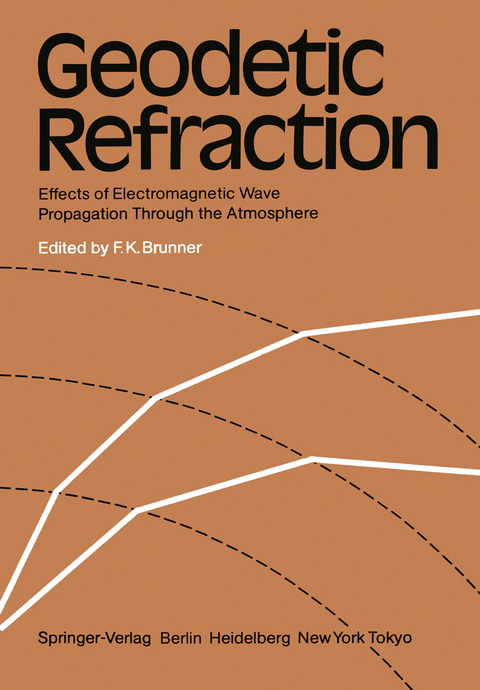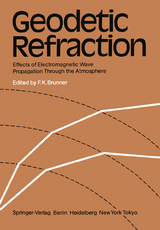Geodetic Refraction
Springer Berlin (Verlag)
978-3-540-13830-3 (ISBN)
With very few exceptions, geodetic measurements use electro magnetic radiation in order to measure directions, distances, time delays, and Doppler frequency shifts, to name the main ter restrial and space observables. Depending on the wavelength of the radiation and the purpose of the measurements, the follow ing parameters of the electromagnetic wave are measured: ampli tude, phase, angle-of-arrival, polarisation and frequency. Ac curate corrections have to be applied to the measurements in order to take into account the effects of the intervening medium between transmitter and receiver. The known solutions use at mospheric models, special observation programs, remote sensing techniques and instrumental methods. It has been shown that the effects of the earth's atmospheric envelope present a fundamental limitation to the accuracy and precision of geodetic measurements. This applies equally to ter restrial and space applications. Instrumental accuracies are al ready below the atmospherically induced limitations, and thus the accuracy demands on the geodetic refraction solutions are entering a new magnitude zone. This monograph is primarily devoted to the properties of the at mospheric effects on various geodetic measurements and to their evaluation. Ten review papers cover the most pressing aspects of the atmospheric effects on geodetic measurement~. Ttiese state of-the art papers were written by eminent specialists in their respective research fields.
A. Overview of Geodetic Refraction Studies.- 1. Introduction.- 2. The Challenge.- 3. Organisation.- References.- B. Two Wavelength Angular Refraction Measurement.- 1. Introduction.- 2. Theory of the Method.- 3. Instrumental Methods.- 4. Concluding Discussion.- Appendix: Notation.- References.- C. Effects of Atmospheric Turbulence on Geodetic Interference Measurements: Methods of its Reduction.- 1. Introduction.- 2. Signal-to-Noise Ratio.- 3. Angle-of-Arrival Fluctuation: Estimation of the Effect.- 4. Linear Interference Measurements: Fluctuation Effect and its Reduction.- Appendix: Notation.- References.- D. Multiple Wavelength Electromagnetic Distance Measurement.- 1. Introduction.- 2. Instrument Design - General Principles.- 3. Instrument Design - Engineering Tradeoffs.- 4. Proposed Instrument Design.- 5. Current Instrument.- References.- E. Water Vapor Radiometry in Geodetic Applications.- 1. Introduction.- 2. The Problem.- 3. Formulation of the Algorithm.- 4. Determination of "Constants" in the Algorithm.- 5. Instrumentation.- 6. Vapor Effects on Baseline Determination.- 7. Summary and Conclusions.- Appendix A: Notation.- References.- F. Temperature and Humidity Structure in the Lower Atmosphere.- 1. Introduction.- 2. Broad Considerations.- 3. The Atmospheric Surface Layer.- 4. The Atmospheric Boundary Layer.- 5. Surface Complexities.- Notation.- References.- G. Modelling of Atmospheric Effects on Terrestrial Geodetic Measurements.- 1. Introduction.- 2. Concept of Modelling.- 3. The Atmospheric Turbulence Model.- 4. Integral Models for r?.- 5. Model Evaluation.- 6. Conclusion.- Appendix A: Notation.- References.- H. Refraction in Geodetic Levelling.- 1. Introduction.- 2. Investigations of Refraction by Kukkamäki.- 3. General Equation for LevellingRefraction.- 4. Temperature Gradient in the Atmospheric Boundary Layer.- 5. The Holdahl Model for Levelling.- 6. National Geodetic Survey Tests.- 7. Investigations using Angus-Leppan Equations.- 8. Statistical Analysis.- 9. Systematic and Random Effects.- 10. Conclusions.- Appendix: Notation.- I. Atmospheric Refraction Effects in Time and Latitude Observations Using Classical Techniques.- 1. Introduction.- 2. Expressions for Astronomical Refraction.- 3. Refraction Problems in VZT, PZT and Astrolabe Observations.- 4. Actual Atmospheric Structure.- 5. Refraction Effects and Meteorological Improvements for Their Corrections.- 6. Concluding Remarks.- References.- J. The Equations of Electromagnetic Wave Propagation in a Refractive Medium Corotating with the Earth.- 1. Introduction.- 2. The Variational Problem.- 3. The Variational Principle of the Wave Equations in an Electromagnetic Medium.- 4. A Discussion of the Wave Equation in an Earth-Fixed Frame.- Appendix A: Notation.- Appendix B: The Formal Structure of Electromagnetism.- References.
| Erscheint lt. Verlag | 1.11.1984 |
|---|---|
| Zusatzinfo | XII, 216 p. |
| Verlagsort | Berlin |
| Sprache | englisch |
| Maße | 170 x 244 mm |
| Gewicht | 430 g |
| Themenwelt | Naturwissenschaften ► Biologie ► Ökologie / Naturschutz |
| Naturwissenschaften ► Geowissenschaften ► Geologie | |
| Naturwissenschaften ► Geowissenschaften ► Geophysik | |
| Naturwissenschaften ► Physik / Astronomie ► Angewandte Physik | |
| Technik ► Umwelttechnik / Biotechnologie | |
| Schlagworte | air pollution and air quality • Atmosphere • magnetism • Modelling • organization • Radiation • Remote Sensing • Research • Statistical Analysis • Temperature • Water |
| ISBN-10 | 3-540-13830-7 / 3540138307 |
| ISBN-13 | 978-3-540-13830-3 / 9783540138303 |
| Zustand | Neuware |
| Haben Sie eine Frage zum Produkt? |
aus dem Bereich




